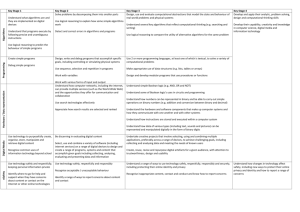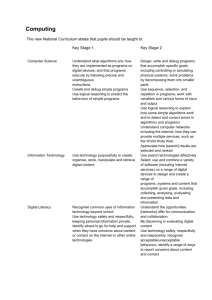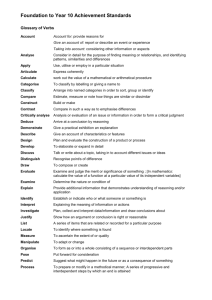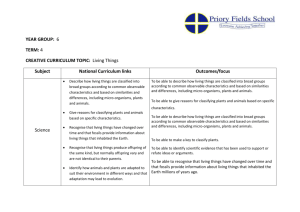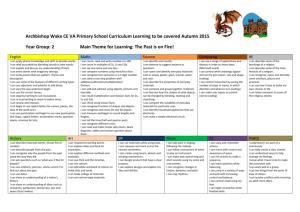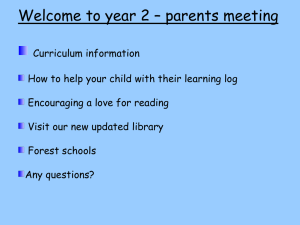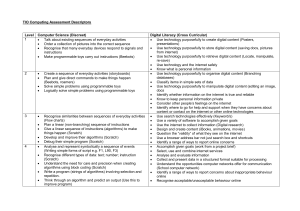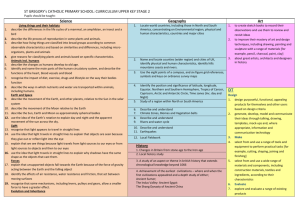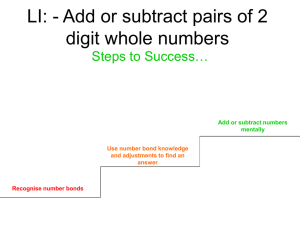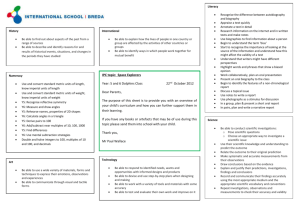SCAM 1.3 - Somerset Learning Platform
advertisement
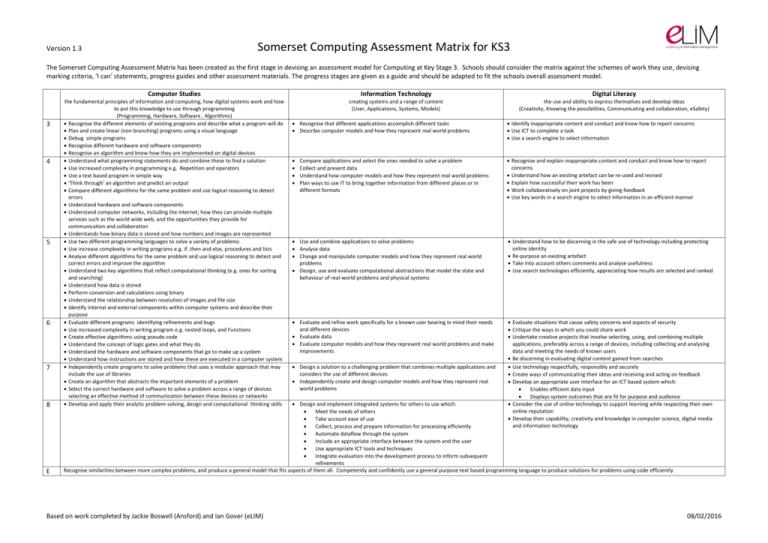
Somerset Computing Assessment Matrix for KS3 Version 1.3 The Somerset Computing Assessment Matrix has been created as the first stage in devising an assessment model for Computing at Key Stage 3. Schools should consider the matrix against the schemes of work they use, devising marking criteria, ‘I can’ statements, progress guides and other assessment materials. The progress stages are given as a guide and should be adapted to fit the schools overall assessment model. 3 4 5 6 7 8 E Computer Studies Information Technology Digital Literacy the fundamental principles of information and computing, how digital systems work and how to put this knowledge to use through programming (Programming, Hardware, Software , Algorithms) Recognise the different elements of existing programs and describe what a program will do Plan and create linear (non branching) programs using a visual language Debug simple programs Recognise different hardware and software components Recognise an algorithm and know how they are implemented on digital devices Understand what programming statements do and combine these to find a solution Use increased complexity in programming e.g. Repetition and operators Use a text based program in simple way ’Think through’ an algorithm and predict an output Compare different algorithms for the same problem and use logical reasoning to detect errors Understand hardware and software components Understand computer networks, including the internet; how they can provide multiple services such as the world wide web, and the opportunities they provide for communication and collaboration Understands how binary data is stored and how numbers and images are represented Use two different programming languages to solve a variety of problems Use increase complexity in writing programs e.g. if..then and else, procedures and lists Analyse different algorithms for the same problem and use logical reasoning to detect and correct errors and improve the algorithm Understand two key algorithms that reflect computational thinking (e.g. ones for sorting and searching) Understand how data is stored Perform conversion and calculations using binary Understand the relationship between resolution of images and file size Identify internal and external components within computer systems and describe their purpose Evaluate different programs identifying refinements and bugs Use increased complexity in writing program e.g. nested loops, and Functions Create effective algorithms using pseudo code Understand the concept of logic gates and what they do Understand the hardware and software components that go to make up a system Understand how instructions are stored and how these are executed in a computer system Independently create programs to solve problems that uses a modular approach that may include the use of libraries Create an algorithm that abstracts the important elements of a problem Select the correct hardware and software to solve a problem across a range of devices selecting an effective method of communication between these devices or networks Develop and apply their analytic problem-solving, design and computational thinking skills creating systems and a range of content (User, Applications, Systems, Models) the use and ability to express themselves and develop ideas (Creativity, Knowing the possibilities, Communicating and collaboration, eSafety) Recognise that different applications accomplish different tasks Describe computer models and how they represent real world problems Identify inappropriate content and conduct and know how to report concerns Use ICT to complete a task Use a search engine to select information Recognise and explain inappropriate content and conduct and know how to report concerns Understand how an existing artefact can be re-used and revised Explain how successful their work has been Work collaboratively on joint projects by giving feedback Use key words in a search engine to select information in an efficient manner Compare applications and select the ones needed to solve a problem Collect and present data Understand how computer models and how they represent real world problems Plan ways to use IT to bring together information from different places or in different formats Use and combine applications to solve problems Analyse data Change and manipulate computer models and how they represent real world problems Design, use and evaluate computational abstractions that model the state and behaviour of real-world problems and physical systems Understand how to be discerning in the safe use of technology including protecting online identity Re-purpose an existing artefact Take into account others comments and analyse usefulness Use search technologies efficiently, appreciating how results are selected and ranked Evaluate and refine work specifically for a known user bearing in mind their needs and different devices Evaluate data Evaluate computer models and how they represent real world problems and make improvements Evaluate situations that cause safety concerns and aspects of security Critique the ways in which you could share work Undertake creative projects that involve selecting, using, and combining multiple applications, preferably across a range of devices, including collecting and analysing data and meeting the needs of known users Be discerning in evaluating digital content gained from searches Use technology respectfully, responsibly and securely Create ways of communicating their ideas and receiving and acting on feedback Develop an appropriate user interface for an ICT based system which: Enables efficient data input Displays system outcomes that are fit for purpose and audience Consider the use of online technology to support learning while respecting their own online reputation Develop their capability, creativity and knowledge in computer science, digital media and information technology Design a solution to a challenging problem that combines multiple applications and considers the use of different devices Independently create and design computer models and how they represent real world problems Design and implement integrated systems for others to use which: Meet the needs of others Take account ease of use Collect, process and prepare information for processing efficiently Automate dataflow through the system Include an appropriate interface between the system and the user Use appropriate ICT tools and techniques Integrate evaluation into the development process to inform subsequent refinements Recognise similarities between more complex problems, and produce a general model that fits aspects of them all. Competently and confidently use a general purpose text based programming language to produce solutions for problems using code efficiently Based on work completed by Jackie Boswell (Ansford) and Ian Gover (eLIM) 08/02/2016

